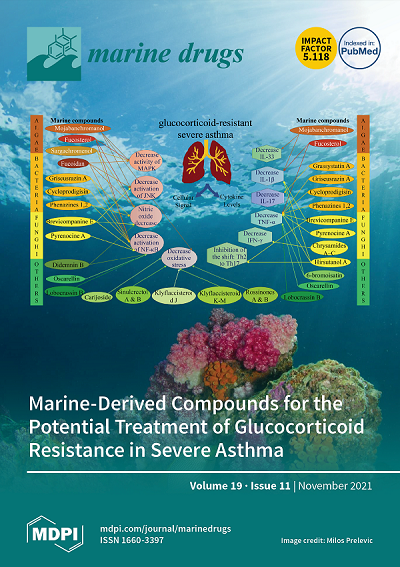来自西北太平洋海洋海绵 Lissodendoryx papillosa 的含 L-Idonic Acid 核心的抗菌 4-溴吡咯烷类生物碱 Stonikacidin A
IF 4.9
2区 医学
Q1 CHEMISTRY, MEDICINAL
引用次数: 0
摘要
从海洋海绵 Lissodendoryx papillosa 中分离出的 Stonikacidin A (1),是含有醛酸核心的新型 4-溴吡咯生物碱的第一个代表。该化合物是为了纪念海洋天然化学领域杰出的研究者之一 Valentin A. Stonik 教授而命名的。利用核磁共振、质谱分析和化学相关性确定了 1 的结构。通过比较从 1 和标准己糖的水解产物中获得的甲基-五乙酰-醛酸酯的气相色谱、核磁共振、质谱和旋光数据,确定了 L-idonic 酸核心。通过对 1 的水解产物 (S)-2 丁酯的五乙酸酯进行气相色谱分析,并与 L- 和 D-idonic 酸的相应衍生物进行比较,确认了 1 中 idonic 酸残基的 L-形式。提出了石蒜碱 A(1)的生物合成途径。生物碱 1 可抑制金黄色葡萄球菌和大肠杆菌试验菌株的生长,并影响金黄色葡萄球菌和大肠杆菌生物膜的形成。分子对接数据显示,石蒜碱 A(1)能与分选酶 A 结合,是因为其溴原子与该酶的一些氨基酸残基之间存在相互作用。本文章由计算机程序翻译,如有差异,请以英文原文为准。
Stonikacidin A, an Antimicrobial 4-Bromopyrrole Alkaloid Containing L-Idonic Acid Core from the Northwestern Pacific Marine Sponge Lissodendoryx papillosa
Stonikacidin A (1), the first representative of a new class of 4-bromopyrrole alkaloids containing an aldonic acid core, was isolated from the marine sponge Lissodendoryx papillosa. The compound is named in honor of Prof. Valentin A. Stonik, who is one of the outstanding investigators in the field of marine natural chemistry. The structure of 1 was determined using NMR, MS analysis, and chemical correlations. The L-idonic acid core was established by the comparison of GC, NMR, MS, and optical rotation data of methyl-pentaacetyl-aldonates obtained from the hydrolysis products of 1 and standard hexoses. The L-form of the idonic acid residue in 1 was confirmed by GC analysis of pentaacetate of (S)-2-butyl ester of the hydrolysis product from 1 and compared with corresponding derivatives of L- and D-idonic acids. The biosynthetic pathway for stonikacidin A (1) was proposed. The alkaloid 1 inhibited the growth of Staphylococcus aureus and Escherichia coli test strains, as well as affected the formation of S. aureus and E. coli biofilms. Compound 1 inhibited the activity of sortase A. Molecular docking data showed that stonikacidin A (1) can bind with sortase A due to the interactions between its bromine atoms and some amino acid residues of the enzyme.
求助全文
通过发布文献求助,成功后即可免费获取论文全文。
去求助
来源期刊

Marine Drugs
医学-医药化学
CiteScore
9.60
自引率
14.80%
发文量
671
审稿时长
1 months
期刊介绍:
Marine Drugs (ISSN 1660-3397) publishes reviews, regular research papers and short notes on the research, development and production of drugs from the sea. Our aim is to encourage scientists to publish their experimental and theoretical research in as much detail as possible, particularly synthetic procedures and characterization information for bioactive compounds. There is no restriction on the length of the experimental section.
 求助内容:
求助内容: 应助结果提醒方式:
应助结果提醒方式:


